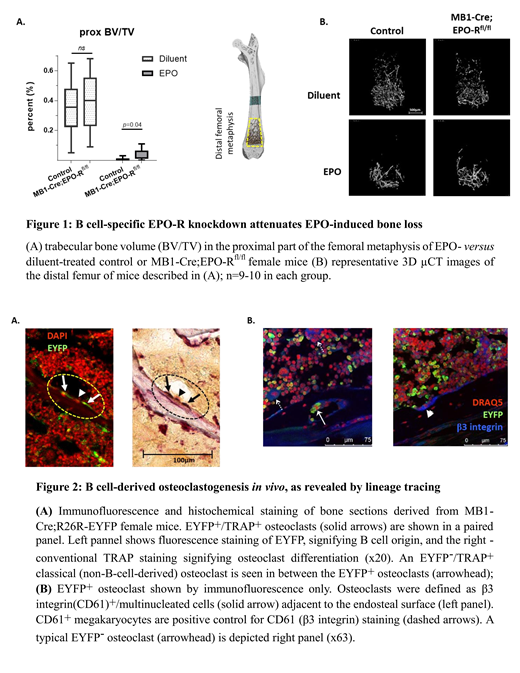Background and aims: Erythropoietin (EPO) is the key regulator of red blood cell production, commonly used in clinical practice to treat certain forms of anemia. Our studies and those of others have demonstrated that EPO administration induces substantial trabecular bone loss. We proposed that EPO-induced bone loss is partially mediated by subsets of bone marrow (BM) B cells that express EPO-R. Mechanistically, EPO upregulates the surface expression of RANKL by BM B cells and augments B cell-derived osteoclastogenesis in vitro. We showed that the latter is likely mediated by pro-B cells expressing the MCS-F receptor (CD115) and capable of transdifferentiation to osteoclasts (Abstract # 1007, EHA 2017). Here we address the role of B cell-specific EPO-R in EPO-induced bone loss (i.e. at supra-physiological EPO levels). Moreover, we demonstrate, for the first time, the occurrence of B cell-derived osteoclastogenesis in vivo, a finding of critical importance in the field of osteohematology.
Methods: In order to trace the B cell lineage from its earliest precursors, we used the MB1-Cre mouse line combined with either the R26R-EYFP or the EPO-Rfl/fl mice for lineage tracing and B cell-specific EPO-R knockdown, respectively. Sequential fluorescence and light microscopy were used for the demonstration of B cell-derived osteoclastogenesis in vivo. Human recombinant EPO was administered in vivo at a dose of 180IU thrice weekly for two weeks. Immunophenotyping of BM B cell populations was assessed by multi-color flow cytometry.
Results: Using female MB1-Cre; EPO-Rfl/fl (cKD) mice, we found that B cell-specific EPO-R knockdown attenuated the profound EPO-induced trabecular bone loss in the proximal part of the femoral distal metaphysis (proximal BV/TV 0.034±0.012% vs 0.007±0.003% in the cKD vs control mice, p<0.05, Figure 1). Remarkably, this effect was observed despite the fact that cKD mice attained higher hemoglobin levels following EPO treatment (21.1±0.1 mg/dL vs 20.4±0.2 mg/dL in the cKD vs control mice, p<0.05). An EPO-induced increase in CD115+ Pro-B cells was observed in EPO-treated control mice but was absent in the cKD mice. The latter finding correlates with the observed bone loss and indicates that the increased number of MCSF-R-expressing pro-B cells is dependent on B cell EPO-R. Supporting the osteoclastic potential of this specific B cell subpopulation is the fact that most of the CD115+ Pro-B cells also express β3 integrin (CD61) which is essential for osteoclast differentiation and function.
Using the MB1-Cre;R26R-EYFP murine model for B cell lineage tracing, we could demonstrate that some of the TRAP+/ β3 integrin+ bone lining cells were also positive for EYFP (Figure 2). This demonstrates the B cell origin of some of the osteoclasts in vivo.
Conclusions: Our work highlights B cells as an important extra-erythropoietic target of EPO-EPO-R signaling that regulates bone homeostasis and might also indirectly affect EPO-stimulated erythropoietic response. The relevance and the mechanisms of the latter phenomenon merits further investigation. Importantly, we present here, for the first time, histological evidence for B cell-derived osteoclastogenesis in vivo, thus opening novel research avenues.
DN and YG Equal contribution
Funded by the German Israel Foundation, Grant # 01021017 to YG, DN, MR and BW and by the Israel Science Foundation (ISF) Grant No. 343/17 to DN.
Mittelman:Novartis: Honoraria, Research Funding, Speakers Bureau.
Author notes
Asterisk with author names denotes non-ASH members.


This feature is available to Subscribers Only
Sign In or Create an Account Close Modal